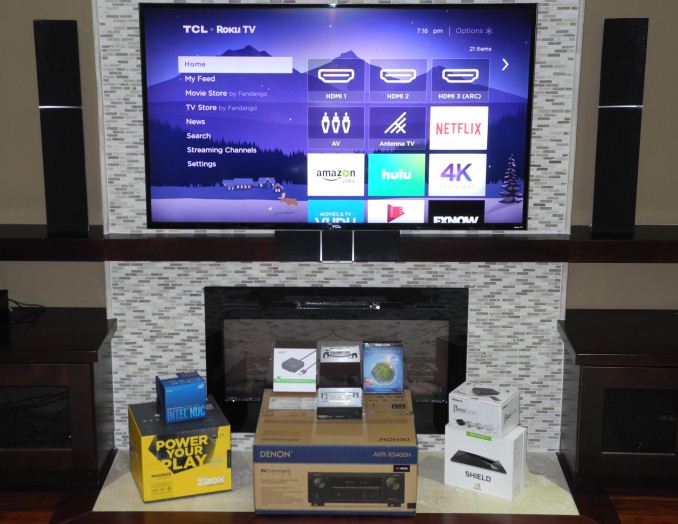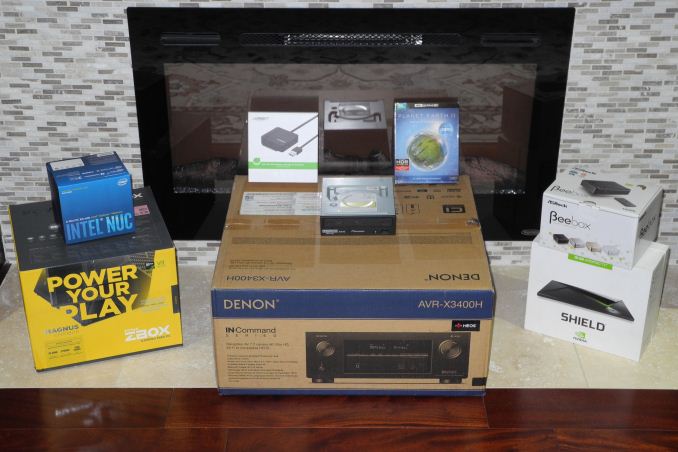A Budget Home Theater & PC Setup: 4K, HDR, UHD Blu-ray, and More
by Ganesh T S on December 26, 2017 8:30 AM EST
The days of bulky HTPCs with built-in optical drives, massive internal storage arrays, and integrated TV tuners are long gone. The advent of over the top (OTT) online streaming services has moved a lot of functionality to the cloud. As NAS units become more powerful, it has made sense to move local media files to a central repository. All these have enabled the TV-connected PC to become more compact. Unless the consumer has specific requirements (like, say, high quality gaming), even ultra-compact form factor (UCFF) machines such as the Intel NUCs can fit the bill.
Home Theater Components: Keeping up with the Times
The primary functionality of HTPCs has evolved to become one of a powerful and versatile media player. However, recent advances such as 4K and high dynamic range (HDR) videos, as well as stricter DRM requirements such as HDCP 2.2 for premium content have made the perfect HTPC platform difficult to achieve. Before delving deeper into these new advances, it is helpful to have some insight into how the landscape has changed over the last decade or so. The advancements in that timeframe have meant that next attractive home theater feature was always around the corner. In the initial days of 720p televisions and other home theater equipment, it was Full HD (1080p). As 1080p became widespread, it was HD audio bitstreaming. After that, 3D support was sought after. A brief lull ensued before the market started slowly getting ready for 4K.
Over the last year or so, we have seen the appearance of displays and audio/video receivers (AVRs) supporting HDMI 2.0 / HDCP 2.2 along with HDR / Dolby Vision. Despite the announcement of HDMI 2.1, I believe that we have reached a point where it is possible to purchase a relatively inexpensive home theater and HTPC configuration without worrying about it getting obsolete within the the next 3 to 5 years.
On the media side, OTT streaming services have become popular to the extent that Netflix and YouTube moved to offer 4K videos to consumers ahead of Blu-rays. Fortunately, many modern PCs are capable of 4K Netflix playback, though HDR is available only on a subset of those configurations. UHD Blu-ray playback support is available through CyberLink PowerDVD 17. However, the hardware requirements are a lot more specific compared to premium OTT services. UHD Blu-ray playback with HDR requires that the home theater components fulfill additional requirements.
Building a Home Theater on a Budget
I started work on this home theater piece back in June 2017. The aim was to present a setup (TV, AVR, and HTPC) with all the bells and whistles, yet light on the wallet. While the TV (TCL 55P607) and the AVR (Denon AVR X3400H) were easy to narrow down based on the feature requirements and budget, the PC side proved to be more challenging. Our core requirements (compact form factor, 4K Netflix support, and HDR capability) narrowed down the choices to a NVIDIA Pascal GPU-equipped PC or a Kaby Lake PC with HDCP 2.2 capabilities. UHD Blu-ray support further narrowed this down to certain Kaby Lake PCs with a HDMI 2.0 / HDCP 2.2 display output.
In the course of our evaluation, we found that consumer electronic (CE) equipment almost always received features ahead of HTPC platforms. Keeping this in mind, we ended up evaluating a number of options for the fulfillment of HTPC duties
- Roku Smart TV platform in the TCL 55P607
- NVIDIA SHIELD Android TV (SATV)
- Zotac ZBOX MAGNUS EN1080K
- ASRock Beebox-S 7200U
- Intel NUC7i7BNHX
Prior to looking at the performance of these options, it will be of interest to readers to delve deeper into our choice for the other home theater components. Earlier this year, I happened to embark on a house remodel, and I took that opportunity to revamp the HTPC test components used in our system reviews. Our choice of components is geared towards a typical family room (15' x 15') home theater.











191 Comments
View All Comments
Bullwinkle-J-Moose - Thursday, December 28, 2017 - link
Quote from edzieba....."That's... not how things work. At all. Adding an S/PDIF cable is not going to magically allow transport of audio streams that:
a) Are too high bitrate for S/PDIF (which cannot even carry 5.1 LPCM)
b) Were developed decades after the S/PDIF standard "
----------------------------------------------------------------------------------------------
You seem to be forgetting that "I make the standards for MY Home Theater Setup" / Not You!
I was designing multi-channel Audio Systems before "your" alleged standards existed
You are once again thinking you must use what the market dictates, even when the market standard is pure CRAP!
I build for "MY" standards which seem to be considerably higher than yours
gerz1219 - Tuesday, December 26, 2017 - link
By that logic, why even bother adding an AVR? You could just use the built-in TV speakers.The point of this article is to lay out what equipment is necessary to enjoy all the latest home theater formats and features. Keeping your old 720p plasma from 2008 is always the "budget" solution for people who don't need the latest and greatest. That's irrelevant in the context of this article.
Gasaraki88 - Wednesday, December 27, 2017 - link
You obviously don't know anything about new technology. TOSLINK is not going to pass Dolby Atmos and DTS:X from the TV to the receiver.So get out of here.
Bullwinkle-J-Moose - Friday, December 29, 2017 - link
"You obviously don't know anything about new technology. TOSLINK is not going to pass Dolby Atmos and DTS:X from the TV to the receiver."-------------------------------------------------------------
LOL, I obviously do
I created better standards than Dolby ever did and was doing it before Dolby ever created their very first surround format
I simply choose to get better audio imaging accuracy through carefully matched drivers, hybrid crossovers and components and custom circuitry
I could easily encode audio to the vast majority of new technology "Standards" you ramble on about but can easily surpass the imaging accuracy of others by using a higher standard........
My own!
But for a "BUDGET" Home Theater system, I cannot personally make a better speaker than the JBL LSR305
and I DO NOT need an AVR if I will not be using the pseudo Standards of others
Tell me, if the "New Technology" you speak of is the "Standard" that everyone must use, then what EXACTLY is NEW and why so many "Standards" ?
Reflex - Friday, December 29, 2017 - link
I can't wait to try all the content coming out in the BJM standard!Bullwinkle-J-Moose - Friday, December 29, 2017 - link
"I can't wait to try all the content coming out in the BJM standard!"---------------------------------------------------------------------------------------
It may be a long wait
Much of the best tech fails in the audio market
Blatant Lies, slick/false advertising and pseudo standards usually win in the marketplace
Does that make them better?
Reflex - Friday, December 29, 2017 - link
It's just not important. The content is being mastered in Dolby Atmos. It's reasonable to build a system that supports that so that I don't miss out. No clever component choices nor ideal speaker placement can change the fact that if I'm running a setup that isn't Atmos capable it won't generate Atmos effects when I play back such content. And quite frankly Atmos is the biggest leap in audio I've seen since 5.1 first hit.I'm glad what you have works for you. If that's all you need there is nothing wrong with that. For myself after trying Atmos at a friend's I wanted it at home and it was well worth the upgrade.
JSStewart - Thursday, January 4, 2018 - link
Hokey smokes, who cares what a stupid moose troll thinks?I will go with the squirrel any day.
wiyosaya - Friday, January 5, 2018 - link
It's called technological progress.wiyosaya - Friday, January 5, 2018 - link
or even DTS HD-MA or Dolby TrueHD